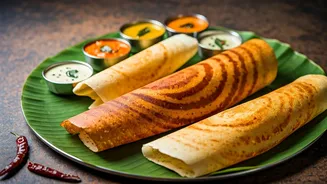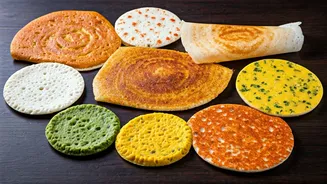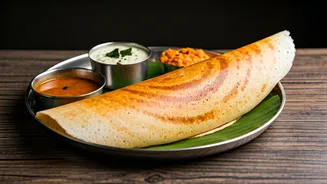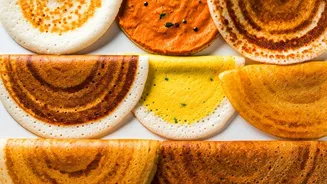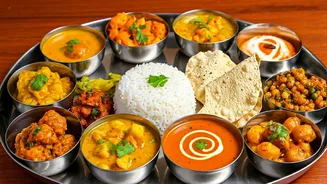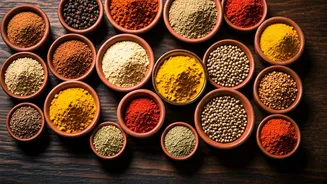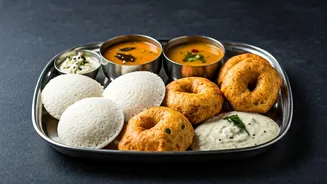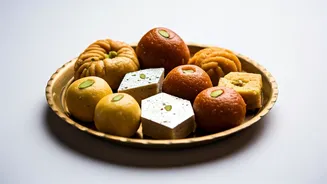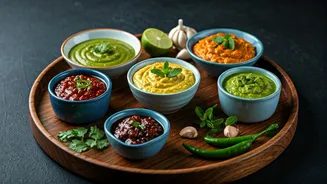Dosa Origins and Appeal
The dosa, a beloved South Indian breakfast staple, boasts a rich history. Its origins can be traced back centuries, evolving through regional variations
and diverse cooking methods. The appeal of the dosa lies in its versatility. The fermented batter gives the dosa its characteristic tangy flavor and a light, crispy texture that can be enjoyed with an array of fillings and accompaniments. Whether it's the simplicity of a plain dosa, the richness of a masala dosa, or the unique flavors of a specific regional variety, dosas cater to a wide range of tastes. Their widespread popularity in South India is a testament to the dosa's enduring appeal.
Plain Dosa: The Foundation
The plain dosa is the quintessential dosa, serving as the foundation for all other variations. Prepared using a simple batter of fermented rice and lentils, its subtle flavor and crispy texture make it incredibly versatile. It is typically served with sambar, a lentil-based vegetable stew, and coconut chutney. The plain dosa is more than just a dish; it is a blank canvas, ready to be paired with any number of chutneys, sauces, or fillings. The batter's fermentation process is key to developing its characteristic tang and light, airy texture. This makes it a perfect base for more complex dishes or a satisfying standalone breakfast item.
Masala Dosa: Flavorful Filling
Masala dosa elevates the plain dosa with a flavorful potato filling. This filling typically consists of mashed potatoes, onions, spices, and herbs, creating a harmonious blend of flavors and textures. The masala is then placed inside the crispy dosa, often served with sambar and coconut chutney. The preparation is a balance of textures and tastes: the crispiness of the dosa and the softness of the masala filling. The masala itself may vary regionally, with different spices and herbs, but it always provides a delightful, satisfying contrast to the dosa's crisp exterior. It's a filling meal on its own, especially enjoyed by many.
Paper Dosa: Thin Delight
Paper dosa is known for its incredibly thin and crispy nature, resembling a sheet of paper. The batter is spread very thinly on the griddle, resulting in a delicate texture. Often served with sambar and a variety of chutneys, the paper dosa's crispiness is its defining characteristic. The skill lies in achieving the right batter consistency and spreading technique. This gives it the ability to cook evenly without tearing, and it is usually folded into a cone shape. Paper dosa is often enjoyed as a snack or a light meal, appreciated for its delightful crunch and easy portability.
Rava Dosa: Semolina Twist
Rava dosa introduces semolina into the batter, which lends a distinct texture and flavor. The batter also includes rice flour, cumin seeds, and other spices, creating a slightly more robust pancake. This dosa is typically thinner and crispier than the plain dosa, with a slightly nutty flavor from the semolina. It's often served with coconut chutney and sambar. Its unique texture and flavor profile make rava dosa a popular choice, particularly for those looking for a variation on the classic. The slight crunch and the subtle spice notes make rava dosa a delicious alternative.
Onion Uthappam: Savory Pancake
Uthappam is a thicker, pancake-like variation of the dosa. This version incorporates finely chopped onions and other vegetables into the batter, infusing it with flavor and texture. It's often served with a variety of chutneys and sambar. The uthappam offers a heartier experience than the thinner dosas. The added vegetables provide a welcome bite and enhanced flavors. This dish can be customized with various toppings and ingredients, such as tomatoes, chilies, and coriander leaves, offering endless possibilities for a personalized breakfast.
Ghee Roast Dosa: Buttery Delight
The ghee roast dosa enhances the traditional dosa by cooking it in generous amounts of ghee (clarified butter). This gives the dosa a rich, buttery flavor and a golden-brown, crispy texture. It is often served with sambar and chutney. The aroma of ghee is very inviting. The ghee roast dosa is a true indulgence. The golden-brown exterior and the rich, buttery flavor make it a real treat. Often served as a special breakfast or festive meal. The use of ghee elevates the simple dosa into a gourmet experience, making it a favorite for many South Indians.
Neer Dosa: Soft and Delicate
Neer dosa, meaning 'water dosa' in Kannada, gets its name from its batter, which has a watery consistency. It’s made primarily with rice flour and is characterized by its soft, lacy texture. Unlike the crispy dosa, neer dosa is soft and delicate, typically served with coconut chutney, jaggery, or fish curry. The simplicity of the ingredients belies the elegance of the resulting dish. Neer dosa is not just a food item; it’s an art form, as the thin batter is expertly poured onto the hot griddle to create a delicate and beautiful pancake. The soft and slightly sweet flavor provides a delightful contrast to the accompaniments.
Set Dosa: Stacked Deliciousness
Set dosa is a unique presentation of the dosa, consisting of multiple soft dosas served together. These dosas are thicker and spongier than a regular dosa, often served with sambar and various chutneys. The term 'set' refers to the set of dosas served. The texture of set dosa offers a different experience from the crispy variations, being soft and spongy. The set format allows for easy sharing and sampling of various accompanying dishes. It's an excellent choice for a hearty breakfast or a quick meal. The set dosa provides a filling and satisfying meal for those seeking a softer, more substantial dosa.
